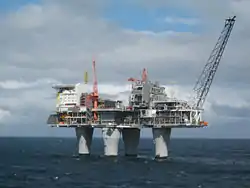Vacuum-anchor
In large scale oceanic civil engineering, vacuum-anchors are ocean bottom fasteners used to anchor deep seas oil platforms (example: See Troll A Oil Platform) and other gravity-based structures[1] in the soupy soft bottomed muck found on many oil bearing continental shelves and the world's shallower seas. Gravity based anchor legs flare out forming a wider footprint where they contact the bottom[1] much as the webbed feet of many aquatic animals increase the surface area above the vacuum-anchors which are open ended long cylindrical shaped deep cups[1] with a sealed top end closed by a valve which connects and anchors mechanically to the legs of the gravity based structure. The valve is used to exhaust any gases and liquid which seeks to escape the trapped sea bottom materials entering the open end of the anchor.

Physically, these are the upscaled analog of a tall drinking glass filled with water then turned upside down and secured in place bottom-side-up. When a lifting or sideways force is applied to such a container, the weight and inertia of the enclosed mass (The mushy gravel, mud, water, and rock solution of the sea bed) must also be displaced (lifted or moved sideways) which anchors them firmly in place within the surrounding materials of the soft bottom. When lifted, any enclosed material attempting to spill out of the enclosure creates a vacuum, just as does the container in the kitchen sink, giving the anchor their name.
Notes
- A National Geographic Channel production, documentary 2007(?), rebroadcast 2009-10-02, 12-13:00 hrs EDST (Comcast Cable Television system)
